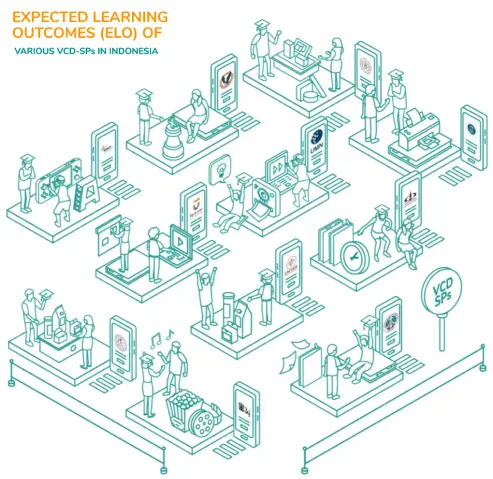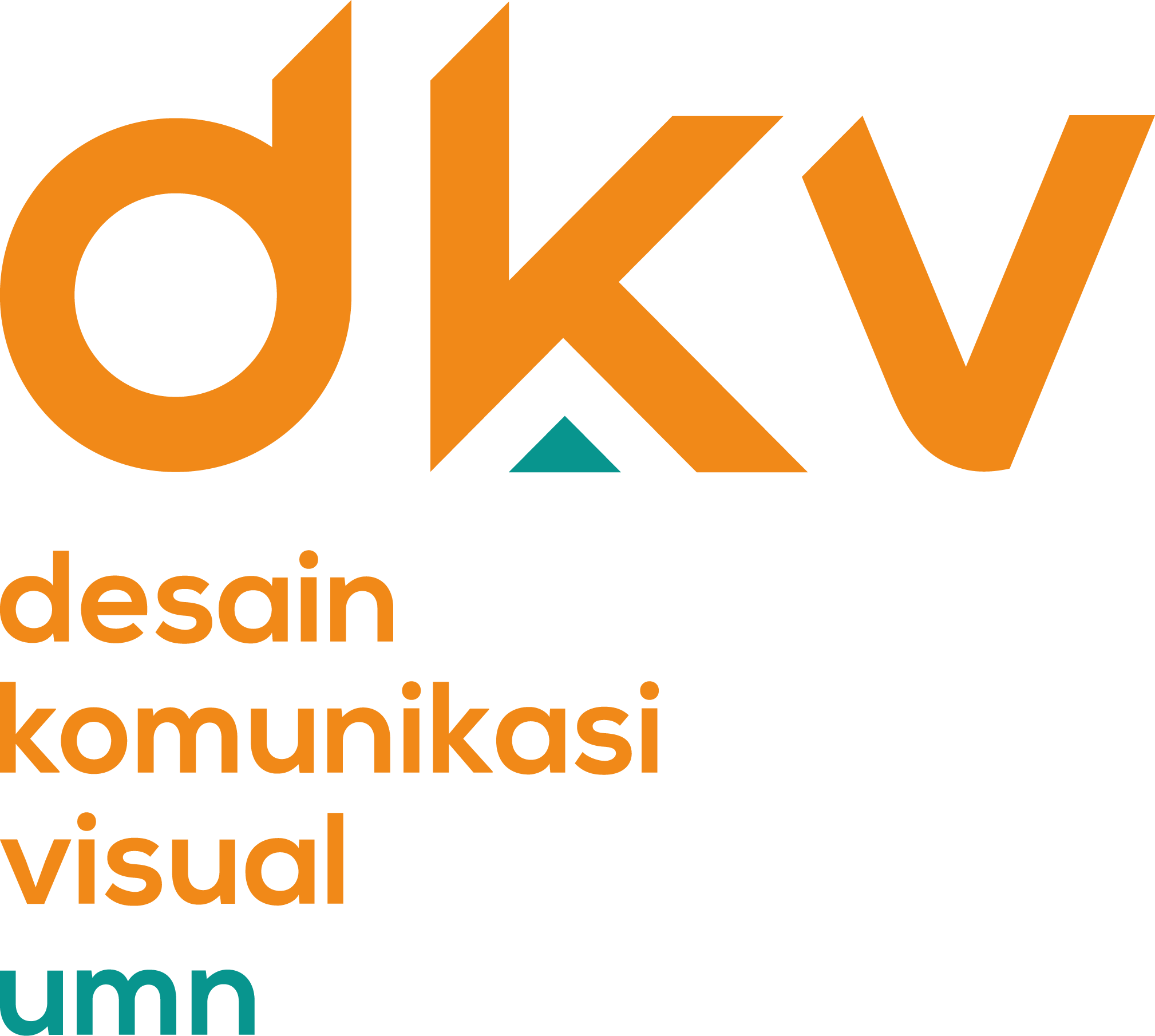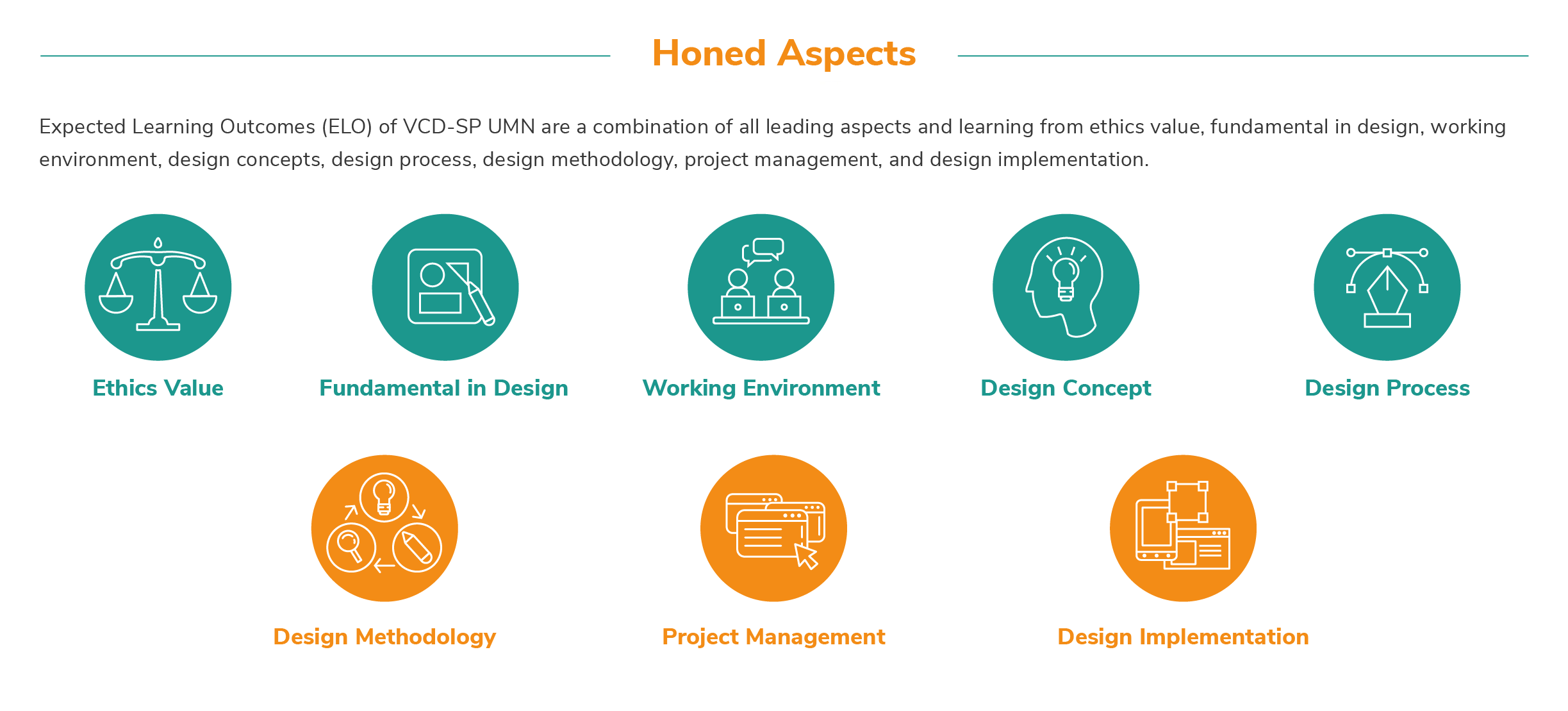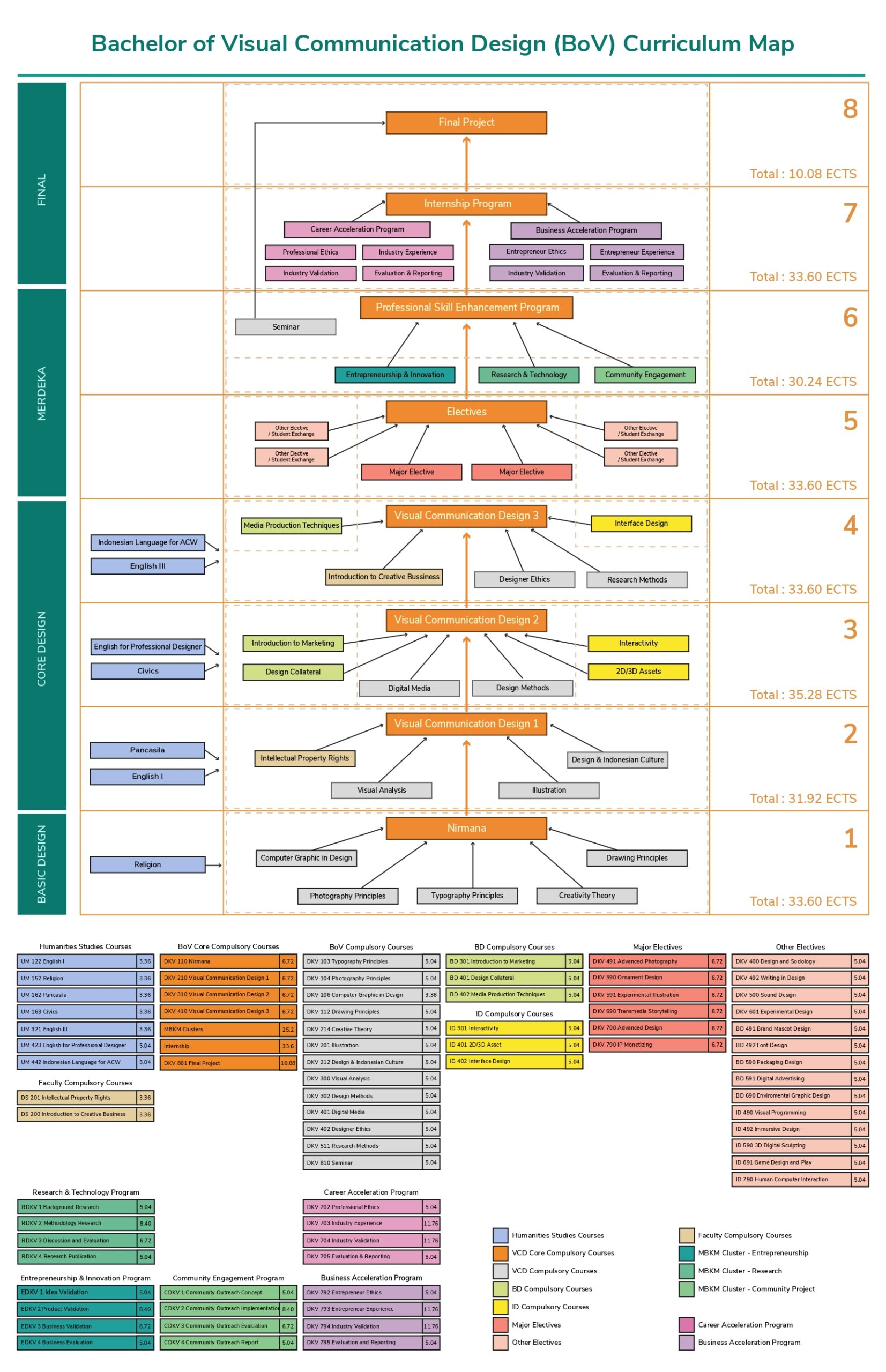Curriculum
ACADEMICS / CURRICULUM / COMPETENCES
ACADEMICS / CURRICULUM / FOCUS
ACADEMICS / CURRICULUM / COURSES
ACADEMICS / CURRICULUM / PRO-STEP
Competences
One of the educational programs of Universitas Multimedia Nusantara Faculty of Art & Design is a Visual Communication Design Study Program with a Bachelor of Design degree (S.Ds.)
The Visual Communication Design Study Program consists of 2 (two) focuses: Visual Brand Design and Interaction Design. The undergraduate study load is minimum credit 144 (SKS) or 241,92 (ECTS), with a curriculum of 8 semesters, duration between 7 to 14 semesters.
The Graduate Competency Matrix, based on the triple helix concept
| NECESSITY | SKILLS NEEDED |
| Society and Government | Graduates who have good attitudes and behavior, communicative, teamwork, creative ability, responsive, improvisation, appreciative, leadership, and proactive (in community development programs, government incubation programs, academic participants in setting standards of work competence by the government, community, and creative associations and social activities related to the knowledge possessed.), supported by leadership and entrepreneurship skills. |
| Professional and Industrial | Graduates who have competencies based on the National Competency Standards in the field of Brand Visual Design (graphic design) and Interaction Design, namely: Able to use traditional art tools, operationalize supporting hardwares & software (Hard Skills), able to perform analysis & evaluation (critical thinking, find & solve problems), able to think creatively (out of the box), and in soft skills able to communicate and work in a team (teamwork). Have the ability to open and develop a business in the design field by applying entrepreneurial and entrepreneurial skills. |
| Academic and Scientific | Graduates who can do knowledge sharing, proactive in scientific development activities, ability to motivate, ability to gain recognitions or professional certification (government) as well as relevantly higher education levels, able to improvise, observe, appreciate and explore science. Able to carry out scientific development (research & development), able to conduct research and experiments, able to formulate and evaluate scientific problems, able to design innovations and make efficient and adaptive, and able to carry out scientific updates on technological and information developments in various conditions and social cultures. |
General, Specific, and Core Competencies
General Competences
-
- Understand the basic principles and knowledge of the art and design process.
- Able to combine design elements such as composition, color, texture, script, and visual ideas as a visual solution in a basic understanding of Visual Communication Design.
- Able to communicate, generate, and present ideas independently or in a group.
- Apply basic design knowledge.
- Applying Indonesian Culture in various design concepts.
- Perform a process of appreciation of the surrounding environment.
- Carry out work activities in the context of a design organization.
- Apply knowledge of graphical methods.
- Operate graphic design software.
- Develop a work portfolio.
- Applying the basic theory of graphic design.
- Compile complete documentation to protect the Rights.
- Intellectual Property of the work produced.
- Prepare a technical brief for print specifications.
- Applying the basic theory of communication.
- Produce creative briefs for the development of design works.
- Coordinate and hold internal meetings with the team.
Specific Competences
Able to accept and understand religious values, nationality, and professional work ethics, as well as social care through the values of Caring, Credible, Competent, Competitive, and Customer Delight, to carry out work according to their field of expertise on a national and global scale. Mastery of global graphic design production and entrepreneurial spirit makes VCD UMN students more representative, superior, and attractive to industry circles with the ability to:
- Calculate production budget.
- Integrate basic knowledge of branding and marketing communications with visual design.
- Develop and understand the concept of IP monetization.
Core Competencies
Mastering visual and communication concepts in branding, advertising, and campaigns by creating communication designs that emphasize the visually artistic side, media exploration, and production techniques through all stages of design development and production including:
- Translating the client brief into the design concept
- Develop and communicate design concepts (Brainstorming)
- Designing work based on the brief
- Determine the material design work
- Present the design results
- Forming a dummy and/or prototype
- Working on the final artwork in various designs
- Evaluating the design work
- Recommending convincing arguments against the design work to the client
- Administer and managing production work teams
Core Competencies
Mastering the concepts of immersion and interactivity for design in interactive media by emphasizing the visually artistic side, gameplay, and interactivity through all stages of production, including:
- Produce products in the form of interactive media
- Solve problems creatively based on design principles, whether through research, practical solutions, aesthetics, and conceptual knowledge
- Communicate ideas and interact with audiences verbally, visually, in writing, and interactively
- Able to execute technically, aesthetically, and make conceptual decisions based on an understanding of the principles of art & design
- Evaluate their work in a professional manner
- Understand and adapt the dynamics that occur in the development of interactive digital art & design
- Learn the professional skills and attitudes needed to compete globally in the art & design field
Honed Aspects
Expected learning Outcomes (ELO) of VCD-SP UMN are a combination of all leading aspects and learning from technology, interactivity, and innovation to compete in Global Industry 4.0 with conceptual thinking, the international standard, entrepreneurship, and new media-oriented.
Outcome-Based Education
Outcome-Based Education (OBE) is an approach that emphasizes the sustainability of the learning process where at the end of the study, each student must be able to achieve the goals set by the Visual Communication Design Study Program.
Competences
Expected Learning Outcome
| Code | Expected Learning Outcome (ELO) | Aspect |
| A | Able to adapt and implement ethics and continuous improvement in design process. | Ethics Value |
| B | Able to apply principle knowledge of visual communication design in design process. | Fundamental in Design |
| C | Able to generate ideas individually and/ or in group works. | Working Environment |
| D | Able to explore concepts in designing with the utilization of ICT. | Design Concept |
| E | Able to determine solution of visual communication problem through design research. | Design Process |
| F | Able to implement design methods and academic writing. | Design Methodology |
| G | Able to manage visual communication design projects as a professional and entrepreneur. | Project Management |
| H | Able to produce and present visual communication design works. | Design Implementation |

Level 1 (Basic Level Learning – Basic Design)
- Able to accept and understand religious values, nationality, and professional work ethics, as well as social care through the values of Caring, Credible, Competent, Competitive, and Customer Delight, to carry out work according to their field of expertise on a national and global scale.
- Understand the basic principles and knowledge of the art and design process.
- Able to combine design elements such as composition, color, texture, characters, and visual ideas as a visual solution in a basic understanding of Visual Communication Design.
- Able to produce visual varieties in form of verbal, graphic, written, and communicative models using manual (traditional) or digital techniques.
- Able to communicate, produce, and present ideas independently or in groups.
Level 2 (Intermediate Level Learning – VCD Pilar)
- Able to understand and carry out the process stages in visual communication design from visual analysis, design methods to production.
- Understand Visual Communication Design problems by considering historical, social, psychological, cultural aspects, and business in the design process.
Level 3 (Advanced Learning – Merdeka)
- Able to analyze visual communication problems and solve problems through research methodology and scientific writing.
- Able to start a business and manage an independent business with entrepreneurial principles in the field of Visual Communication Design.
Level 4 (Final Level Learning – Final)
Able to present and examine designs in the form of visual communication as innovative problem solving using strong concepts and aesthetic values through a global and entrepreneurial perspective that includes identity, information, and persuasion as individuals or groups.
Competences
Lifelong Learning
| No. | Key Competence Lifelong Learning | ELO1 | ELO2 | ELO3 | ELO4 | ELO5 | ELO6 | ELO7 | ELO8 |
| 1 | Communication in the mother tongue | v | v | v | |||||
| 2 | Communication in foreign language | v | v | v | |||||
| 3 | Mathematical competence and basic competences in science and technology | v | v | v | |||||
| 4 | Digital competence | v | v | v | |||||
| 5 | Learning to learn | v | v | v | |||||
| 6 | Social and civic competences | v | v | v | |||||
| 7 | Sense of initiative and entrepreneurship | v | v | ||||||
| 8 | Cultural awareness and expression | v | v | v |
Industries’ Needs Related to ELO
| Job Title/ Profession | Job Description | ELO | Concentration Courses | |||||||
| 1 | 2 | 3 | 4 | 5 | 6 | 7 | 8 | |||
| Graphic Designer | Design a visualization of concepts and layout | v | v | v | v | v | v | Visual Brand Design | ||
| Art Director | Design and be responsible for the visual concept of visual advertising | v | v | v | v | v | v | |||
| Creative Director | Design and be responsible for creative and media strategies | v | v | v | v | v | v | v | v | |
| Copywriter | Design persuasive words as the main support in advertising | v | v | v | ||||||
| Junior Designer | Design a visualization of translating brand concepts | v | v | v | v | |||||
| Senior Designer | Design and be responsible for creative concepts and brand visuals | v | v | v | v | v | ||||
| Technopreneur | Design be responsible and run the development of a creative industry-based business | v | v | v | v | v | v | v | v | |
| Asset Designer | Designing visual media assets both digital and non-digital interactive | v | v | v | v | v | v | Interaction Design | ||
| Junior Designer | Design visualization of interactive concept translation | v | v | v | v | |||||
| Senior Designer | Designing and being responsible for creative concepts and interactive media | v | v | v | v | v | v | |||
| User Experience (UX) Designer | Perform user tests on interactive media | v | v | v | v | v | v | v | ||
| Art Director | Designing and being responsible for the interactive concepts of the media | v | v | v | v | v | v | v | v | |
| Interaction Design | Design and be responsible for patterns and concepts of interaction on interactive media | v | v | v | v | v | v | v | ||
Courses
Learning Methods in VCD UMN
| Visual Brand Design | Interaction Design |
| Mastering visual and communication concepts in branding, advertising, and campaigns by creating communication designs that emphasize the visually artistic side, media exploration, and production techniques through all stages of design development and production, including: 1. Translating client brief into design concepts 2. Develop and communicate the design concepts (Brainstorming) 3. Design work based on brief 4. Determine the material design work 5. Present the design results 6. Form a dummy and/or prototype 7. Work on the final artwork in various designs 8. Evaluate the design work 9. Recommend convincing arguments against design work to clients 10. Administer and manage the production work team | Mastering the concept of immersion and interactivity for design in interactive media by emphasizing the artistic side of visuals, gameplay, and interactivity through all stages of production, including: 1. Produce products in the form of interactive media 2. Solve problems creatively based on design principles, either through research, practical solutions, aesthetics, and conceptual knowledge 3. Communicating ideas and interacting with the audience verbally, visually, in writing, and interactively 4. Able to execute technically, aesthetically, and make conceptual decisions based on an understanding of art & design principles 5. Evaluate their work professionally 6. Understand and adapt the dynamics that occur in the development of interactive digital art & design 7. Learn the professional skills and attitudes needed to compete globally in the field of art & design |
Courses
PRO-STEP
PRO-STEP is the study freedom for Undergraduate students to take credits outside the study program (in one semester) and the freedom to carry out learning activities outside of college (in two semesters).
Academic Requirements:
Students can join the PRO-STEP program with the following academic requirements:
- Active students, at least in the fifth (5) semester.
- Students have completed a minimum total of 90 credits.
PRO-STEP Includes
1. Exchange Students
2. Community Engagement Program
3. Research & Technology Program
4. Entrepreneurship & Innovation Program
The Student Exchange’s aim was knowledge transfer to cover disparities in education in higher education, either domestic or overseas, which includes:
- Study in other Study Programs at the same university.
- Study in the same Study Programs at different universities.
- Study in other Study Programs at different universities.
Goal:
- Study across universities in the country.
- Live with local residents at the destination campus.
- The vision of Bhinneka Tunggal Ika will be more developed to strengthen the cross-cultural brotherhood.
- Building student friendships between regions, ethnic groups, culture, and religion.
- Transfer of knowledge to cover educational disparities, both with fellow domestic universities and with foreign universities.
- Enriching experiences and scientific contexts obtained from destination universities with specific learning support facilities.
The Community Project aims to support government projects related to developing villages or rural areas. Most villages receive government funding, yet their human resources do not have the capability for development planning. Therefore, the effectiveness of using village funds to drive economic growth still needs to be improved through students whose mission is to empower village funds.
Goal:
- The opportunities for students to take advantage of their knowledge, technology, and skills in collaborating with many stakeholders in the field.
- Assist in accelerating the development in rural areas together with the Ministry of Villages, Development of Underdeveloped Regions, and Transmigration.
The Research Cluster is aimed at students that are interested in research activities. They will be given the opportunity to conduct their studies in research institutes, laboratories, and study centers, which are very prestigious.
Goal:
- Improving students’ research quality. In addition, student experience in extensive research projects will strengthen the research pool talent topically.
- Students gain research competence through direct supervision by researchers at research institutes/study centers.
- Improving the ecosystem and research quality in Indonesian laboratories and institutes by providing research resources and regenerating researchers early.
- Increasing research collaboration between UMN and the research and industry institute.
- Improving UMN research outputs, either publication of scientific articles, intellectual property rights, or product innovations.
Through Entrepreneurship, students are expected to understand, identify, analyze, and evaluate the concept as well as the terminology of entrepreneurship so that they may create an innovative and sustainable business idea. It will focus on the study of planning, implementing, and evaluating the business.
Goal:
- Ability to understand the mindset, concept, and terminology of entrepreneurship.
- Ability to identify problems and develop solutions that have business/commercial values.
- Ability to develop solutions from ideas that have sustainable business/commercial values.
- Ability to analyze existing entrepreneurship business models.









